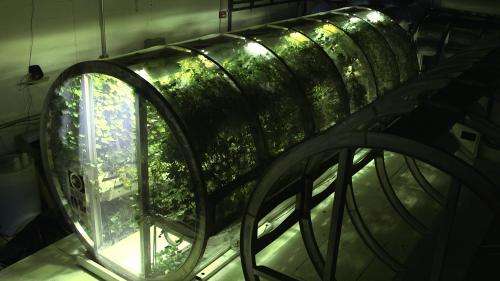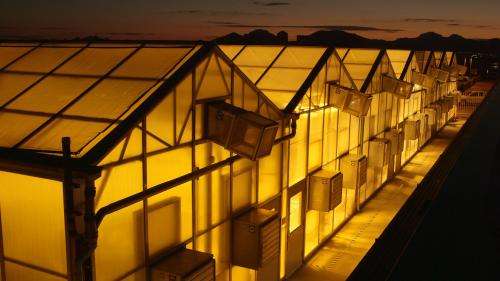Documentary shows how a veggie garden for the moon can sustain life on Earth

(Phys.org) —When Apollo astronauts stood on the moon and looked back at the Earth, they were the first humans to see our planet as a completely isolated system, bounded on all sides by the endless black of space. Now, 45 years later, "Earthlight," a documentary produced by the University of Arizona College of Agriculture and Life Sciences, explores the challenges facing the human race and how the technology scientists are designing to return to the moon might be the key to humans' sustainable presence on Earth.
"Is learning to live on the moon the key to sustainability on Earth?" is the tagline for the film, which will be released this summer. "Earthlight" leads the audience through a story about the current food challenges our civilization faces through the lens of UA scientists who are building a greenhouse food production system that may someday be used on NASA missions to the moon or even Mars. By addressing the challenges of keeping astronauts alive with finite resources, the scientists and technical experts working on the project provide new solutions to sustainable food production on Earth.
"Earthlight" features interviews with NASA scientists, UA researchers and students exploring the urgency of sustainable living and how projects like the lunar greenhouse – a collapsible hydroponic growth chamber with automated light and nutrient cycles that was developed by UA scientists – are key to maintaining a livable planet. A special screening was slated for Wednesday at the Loft Cinema in Tucson.
"In an extraterrestrial space habitat, astronauts have to use finite amounts of water, oxygen and food," said Joel Cuello, professor in the Department of Agricultural and Biosystems Engineering in the UA College of Agriculture and Life Sciences, "and the only way that the lives of astronauts could be sustained in this scenario is through the recycling and reuse of all resources, so that no resource is 'lost' from the system."
Developing sustainable agricultural production methods that approach a zero-loss cycle of resources immediately translates to the need of figuring out how Earth's finite resources can support a population of 9.6 billion by 2050, as projected by the United Nations' Department of Economic and Social Affairs.
"The demand for food will be 70 percent higher than it is now," Cuello said. "Because the environment of space is far more extreme than here on Earth, the integrated built environment needed to sustain life in space is necessarily a closed one. But our advantage here on Earth is that we can apply the same integrative strategies or practices and achieve the same benefit of resource-use effectiveness."
Scientists like Cuello believe that technology represented by the lunar greenhouse may play a part in meeting Earth's food demand while minimizing additional burdens on the natural environment.
The lunar greenhouse attempts to mimic Earth's nutrient, air and water cycles to provide astronauts with a closed ecosystem that can provide all of the fresh water and air that the astronauts will need, as well as fresh vegetables.
"The lunar greenhouse we developed here is essentially a life support system, a plant-growing robot that not only produces food but also makes wastewater potable and air breathable," said Gene Giacomelli, director of the Controlled Environment Agriculture Center, which is part of the College of Agriculture and Life Sciences. He oversees the research and development of the technology and, along with Cuello, is a member of the UA BIO5 Institute.

Based on the construction and design of a hydroponic plant growth chamber, the bioregenerative life support system was built by Sadler Machine Co. and the CEAC. It is a lightweight, aluminum collapsible structure measuring 6 feet in diameter and 18 feet in length.
"This computer-controlled, autonomous system mimics what plants would expect to have on Earth," said the documentary's creator, Cody Sheehy, video producer at the College of Agriculture and Life Sciences. "Astronauts exhale carbon dioxide, which the plants take up and transform into biomass as they grow in the lighted environment. The oxygen they produce in the process is returned to the astronauts to breathe. Water transpired by the plants is collected from the humid air, which can be used as potable water for the crew."
All the while, the lunar greenhouse is monitored and controlled through computer programs using sensors that continuously communicate environmental information. This complex "brain" provides continuous operations, leaving minimal routine labor work for the astronauts.
The robotic garden approaches almost 100 percent sustainability, meaning that it requires minimal resources from Earth in the form of a few pounds of replacement nutrient salts per year for every astronaut it would support.
"Our technology feeds back to the developing and the existing greenhouse industry on Earth," Giacomelli said. "As our resources on Earth are becoming more scarce – water, nutrients, energy, and labor – agriculture is increasingly facing the exact same challenges as growing food on the moon or on Mars."
Some regions on Earth face those challenges already. Last year, Cuello led a group of UA agriculture experts who were invited by the Qatar National Food Security Programme's Office of the Heir Apparent to work on the design of a 100-hectare Qatar Integrated Demonstration Farm.
Cuello said the use of innovative technologies would be effective only if they could be coupled with strategies that recycle resources.
"In other words, the 'waste' of one component becomes the input resource for another component within the same system, so that resource reuse is maximized and a zero-waste system is approached," Cuello said. "This in essence is the core governing design principle for space life support to make possible the design of future space habitation."
Earlier designs of the lunar greenhouse have already been deployed in other harsh environments like Antarctica, where they currently service the National Science Foundation's Amundsen-Scott South Pole Station with fresh vegetables through the darkness of winter.
"Earthlight" will premiere at various outlets at the end of July in honor of the 45th year anniversary of the Apollo landing.
Provided by University of Arizona




















